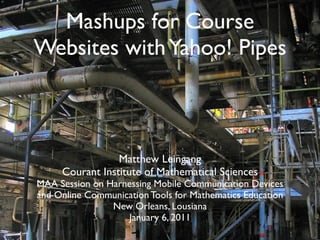
Mashups for Course Websites with Yahoo! Pipes
- 1. Mashups for Course Websites with Yahoo! Pipes Matthew Leingang Courant Institute of Mathematical Sciences MAA Session on Harnessing Mobile Communication Devices and Online Communication Tools for Mathematics Education New Orleans, Lousiana January 6, 2011
- 2. Mashup a web page or application that uses and combines data, presentation or functionality from two or more sources to create new services.
- 3. Example
- 4. Anatomy of a Mashup
- 5. Anatomy of a Mashup Web extract/parse Data
- 6. Anatomy of a Mashup Web extract/parse Data manipulate Data Data “munge”
- 7. Anatomy of a Mashup Web extract/parse Data manipulate Data Data “munge” syndicate Data Web “smush”
- 8. Yahoo! Pipes
- 9. Yahoo! Pipes Feed Items
- 10. CSV HTML Yahoo! Pipes RSS Feed iCal Items
- 11. CSV HTML Yahoo! Pipes RSS Feed iCal Web Items YQL
- 12. CSV HTML Yahoo! Pipes RSS Feed iCal Web Items YQL
- 13. CSV HTML Yahoo! Pipes RSS Feed iCal Web Items RSS Web HTML YQL
- 14. CSV HTML Yahoo! Pipes RSS Feed iCal Web Items RSS Web HTML YQL
- 15. CSV HTML Yahoo! Pipes RSS Feed iCal Web Items RSS Web HTML YQL
- 16. Pipes are made of Modules
- 17. Pipes are made of Modules • Sources (RSS, HTML, CSV, searches) • User Inputs (specified in forms or queries) • Data constructors and manipulators (dates, locations, URLs, strings) • Operators (map, Sort, Filter, Truncate, etc.) • Output (RSS, Web Service)
- 18. Pipes are made of Modules • Sources (RSS, HTML, CSV, searches) • User Inputs (specified in forms or queries) • Data constructors and manipulators (dates, locations, URLs, strings) • Operators (map, Sort, Filter, Truncate, etc.) • Output (RSS, Web Service) • Connecting modules produces output • GUI!
- 19. Example
- 20. Example • Input: static web page with course topics by week • Output: dynamic feed of topical videos • Posted to Blackboard and Facebook
- 21. Input
- 22. Zoom in on the <table highlighted bit
- 23. Fetch
- 24. Fetch
- 25. Fetch A source module
- 26. Fetch
- 27. Fetch An operator module
- 28. Fetch
- 29. Fetch Output
- 30. Chunk
- 31. Chunk
- 32. Chunk
- 33. Clean
- 34. Clean
- 35. Clean
- 36. Parse
- 37. Parse
- 38. Parse
- 39. Parse
- 40. Select
- 41. Select
- 42. Select
- 43. Select
- 44. Select
- 45. Select
- 46. Mashup!
- 47. Mashup!
- 48. Mashup!
- 49. Mashup!
- 50. Publish
- 51. Publish Post automatically to these sites
- 52. Publish or paste this HTML anywhere
- 57. RSS URL
- 62. Other Examples • Post slides on an external site (e.g., scribd, SlideShare) and import to Blackboard • The day’s office hours scraped from Google Calendar and posted to Facebook • Density map of tweeps at a conference
- 63. Pros and Cons
- 64. Pros and Cons • Graphical • Intuitive (eventually) • Powerful • Versatile • Fun
- 65. Pros and Cons • Graphical • Steep learning curve at the start • Intuitive (eventually) • Regular expressions • Powerful even steeper learning curve • Versatile • Slow • Fun • fragile • Perfect is the enemy of the good
- 66. Thank You
- 67. Thank You • More on the web: http://pipes.yahoo.com/ • ReadWriteWeb and Mashable are good Web 2.0 resources • Follow me on Twitter: @mleingang • Coming in Fall 2014: Calculus for the Digital Student by MPL (John Wiley & Sons)
- 68. Credits • “Pipes” by Flickr user autowitch • “Mashup (web application hybrid” Wikipedia • “Hamburger” by Flickr user tomklaver
